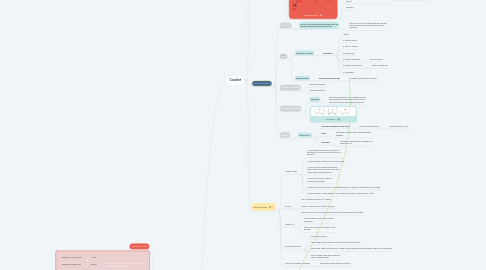
1. Ionic
1.1. Non-metal + Metal
1.2. Ionic bonds is the attraction between the a negative and positive ion
1.2.1. Anion
1.2.1.1. Negatively charged ion
1.2.2. Cation
1.2.2.1. Positively charged ion
1.2.3. Example: Sodium chloride
1.3. Physical properties
1.3.1. Brittle
1.3.2. Soluble in water/not soluble in solvents(Ex. oil, petrol, kerosene)
1.3.3. High electric conductivity in molten state/ insulator in solid-state
1.3.4. High melting and boiling point
1.4. Chemical properties
1.4.1. Create basic solutions and metal oxide
2. allotropes
2.1. link to more info
2.2. covalent molecules can differ within these properties:
2.2.1. structure
2.2.2. electrical conductivity
2.2.3. thermal conductivity
2.2.4. appearance
2.2.5. special properties
2.2.6. practical uses
3. Covalent
3.1. Intermolecular forces
3.1.1. Occurs between opposite charges between neighboring molecules attracting each other.
3.1.2. London dispersion forces
3.1.2.1. Occur between opposition ends of 2 temporary dipoles in molecules
3.1.2.2. It only matters between non-polar molecules
3.1.2.2.1. Reason for how non-polar substances can be condensed to form liquids and solid at low temperature.
3.1.2.3. Example
3.1.3. Dipole-dipole attraction
3.1.3.1. Only in molecules with polar bonds
3.1.3.1.1. Lead to solubility of polar solutes in polar solvents.
3.1.3.2. Occur between opposite charges on neighboring molecules attracting each other.
3.1.3.3. Example
3.1.4. Hydrogen bonds
3.1.4.1. When a molecule contains hydrogen covalently bonded to a very electronegative atom (only fluorine, nitrogen, and oxygen atom)
3.1.4.1.1. Strongest form of intermolecular forces
3.1.4.2. Example
3.2. Covalent structures
3.2.1. definition
3.2.1.1. due to a covalent bond where the electron is being shared between two atoms
3.2.1.1.1. both nuclei of the 2 atoms that are bonded are attracted to the same shared pair of electrons
3.2.2. types
3.2.2.1. molecular covalent
3.2.2.1.1. structures
3.2.2.2. giant covalent
3.2.2.2.1. forms lattice structures
3.2.3. structure properties
3.2.3.1. low melting points
3.2.3.2. low boiling points
3.2.4. resonance structure
3.2.4.1. definition
3.2.4.1.1. is two or more forms of a molecule where the chemical connectivity is the same but the electrons are distributed differently.
3.2.4.2. visualistion
3.2.5. polarity
3.2.5.1. depends on...
3.2.5.1.1. electron negativity of the atom
3.2.5.1.2. polar
3.2.5.1.3. non polar
3.3. Lewis structure
3.3.1. How to draw?
3.3.1.1. 1. Calculate total numbers of valence electrons (# of valence electrons x # of element)
3.3.1.2. 2. Draw skeletal structure of the molecules
3.3.1.3. 3. Use a pair of crosses/dots/single line to show 1 electron pair. Put a pair in each bond between atoms
3.3.1.4. 4. Add more electron pairs to complete the octets
3.3.1.5. 6. Check total # of electrons in finished structure is equal to calculations in first step
3.3.1.6. 5. Form double or triple bonds if not enough electrons to complete the octet
3.3.2. Of Ions
3.3.2.1. Add 1 electron for each (-) charge
3.3.2.2. Remove 1 electron for each (+) charge
3.3.2.3. Put lewis structure in a square bracket with the charge showing outside
3.3.3. What is it?
3.3.3.1. Describe the structure of covalent molecules
3.3.3.2. Dots and crosses to represent outer energy
3.3.4. Coordinate Bonds
3.3.4.1. A.k.a dative bonds
3.3.4.2. Forms when BOTH electrons come from the SAME atom
3.3.4.3. Arrow with a head on the bond Is used to show direction indicating the origin of the electrons
3.3.4.4. Once formed, they’re the same as other covalent bonds
3.3.5. Octet Rule: always followed?
3.3.5.1. some atoms form stable molecules
